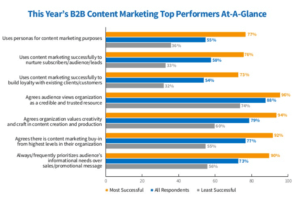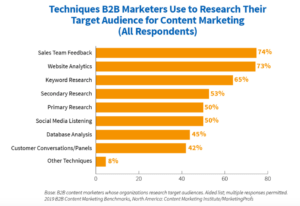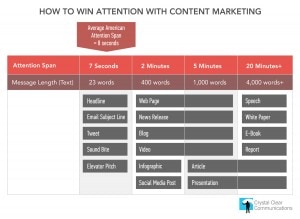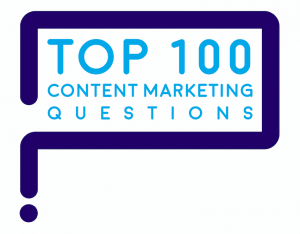
Top 100 Content Marketing Question: How do you prioritize content?
To prioritize content:
- Put your audience needs first.
- Build your content base.
- Create a content calendar, starting with mega-content.
- Ride the currents of trends and news.
1. Put your audience needs first.
To discover what kind of content is best to build, first learn all you can your audience, your tribe and your customers.
The new 2019 CMI/Marketing Profs study shows: the most successful content marketers are those who know their audience best. They get a handle on their audience with buyer persona research.

Learn everything you can about your audience!
The more direct contact you have with customers, the better.
Don’t settle for hearing what Sales says or what website and social analytics show. Marketing needs direct customer input – but only half of marketers get it!

For example, perform buyer persona research to learn:
- What jobs do people have to do?
- What problems must they solve?
- Which pain points do they suffer?
- Where do they seek information?
- Where do they congregate?
- What characterizes their distinct tribe?
- Which common interest(s) do they share?
Once you know your audience up and down, ask: What content could you create that’s so valuable to your audience they would pay for it?
Example: The Red Bulletin, a print and digital magazine of relentlessly exciting content about extreme sports. The Bulletin captures its tribe’s spirit in its mission statement:
The Red Bulletin features breathtaking stories out of the World of Red Bull and its Playgrounds. Delivering the unexpected, the magazine honors those who don’t play by the rules, who push the limits, have a lust for life, swim against the current, who have a passion for adventure and are not afraid to walk courageous new paths.”
Example: Arrow Electronics purchased the top trade websites for electronics engineers. When these engineers have questions, they’re likeliest to get the answers from Arrow’s owned content. Arrow gains the best data on engineers’ interests.
Example: The Michelin Guide expanded the auto market, enabling Michelin to expand from bike tires into car tires.
Brilliantly, Michelin didn’t limit its content to the topics of tires or cars. Instead it leapfrogged to a bigger, more compelling topic: travel. Over a century of consistent content makes its authority supreme.
2. Build your content base.
Put aside smaller projects to clear the way for the most valuable, helpful, unique content asset you will create: your content base.
Think of your content base as the trunk of a tree.

It lifts your content high above competitors to capture more light, more attention, more room to grow.
Once you build a strong trunk — one type of content in one medium, delivered consistently over time — then branch out to other content types.
Unfortunately, most marketers start by creating branches of content first. A blog here, social media post there, maybe a photo contest.
But branches alone create shrubs. They never amount to a tree that towers above others.
In some markets, so many companies create content with branches only, that the whole content landscape becomes a scrubland. Nothing stands out.

In other markets, content competition is as fierce as it is for trees striving to grow in a rainforest. Each brand struggles to reach its moment in the sun.
For instance, food content such as recipes has to thrive in a highly competitive rainforest market.
Survey your market. Do a content audit.
Does your content compete in a scrubland or a rainforest?
Of course, it’s easier to create content that stands out in a desert or scrubland than in a rainforest.
If you’re the first in your market to build a content base, build up your content tree to stand high above others. Once you’ve built a towering content tree, it’s incredibly hard for competitors to catch up.
If your brand needs to stand out in a rainforest of content, focus on truly differentiated content as you:
- Address a specific niche to attract a specific tribe.
- Create differentiated content with its own tilt or hook.
- Speak in a unique brand voice.

Ann Handley encourages you to create a brand voice so distinct that you can hide the brand name and still identify the content source.
For example, Woot’s irreverent voice is unmistakable: “Bestsellers: The deals that you, the public, are telling us you hate the least. Updated every twenty.”
3. Create a content calendar, starting with mega-content.
Start building your editorial calendar with mega-content, advises Heidi Cohen.

Your brand should create up to 4 pieces of mega-content each year: lead magnets, white papers, guidebooks, research studies and so forth.
Build your mega-content around:
- Seasonality
- Events
- Opportunities.
For example, See’s Candies blocks out its content calendar around peak-demand holidays: Valentine’s Day, Easter, Mother’s Day, Halloween, Christmas.
Then it adds more holidays to stimulate demand: Secretary’s Day, Grandparents Day, even the birthday of company founder Mary See.
Where there are 4 seasons, REI builds content around seasons when members engage in particular outdoor sports. For example, people who paddle kayaks in warm weather may also ski in the winter.
REI created its own holiday, #OptOutside, by repurposing a shopping day, Black Friday.
The company invites not only its members, but also the 50% of Americans who don’t go outdoors, to spend a day outside in nature. Brilliant!
Computer gaming company MSI puts its marketing muscle into the Consumer Electronics Show (CES) event, as this Google Trends chart shows.

By focusing all its resources on CES, MSI content maintains a steady heartbeat.
Create content in multiple serving sizes throughout the year.
After you schedule mega-content, fill in your calendar with medium-length (5 minute) and smaller bits of content (7 seconds, 2 minutes). Here are ideas for how to populate different sizes.

4. Ride the currents of trends and news.
Don’t let your editorial calendar get too fixed or rigid. Instead, be flexible and adaptable so you can ride the waves of culture, news and industry trends.
As the year unfolds, you may encounter cultural trends and news hooks that are relevant to your tribe.
Ask: How can you tie your content into the big cultural moves?

For example, Kathleen Diamantakis of the New York Times detects a cultural shift from the search for happiness to the search for meaning, as she discussed at Content Marketing World.
This cultural shift is why you’re hearing more and more about yoga, meditation, and spiritual practices. How can your content ride this rising tide?
Day-to-day, monitor news about topics of interest to your audience. Then you can:
- Post timely social media tidbits that increase relevance.
- Refresh evergreen content by adding a news hook.
- String together news events to detect trends that affect your tribe or industry.
Industry trends shape the content dialogue and direct audience interests.
For example, the mobile device market is focusing on the next generation of cellular networks, 5G.
For technology marketers, now is a great time to address newsy topics such as:
- What is 5G?
- How will 5G and the Internet of Things affect my business?
- When will 5G networks become available?
- When can I buy a 5G handset?
- How long can I keep using my 4G cellphone?
Early in the life of a trend, strong opinions break through.
Since 5G is in its early days, perceptions about it can be shaped by gurus who predict what will happen next — and what it means to the audience. What’s in it for them? Why should they care?
To prioritize content:
- Put your audience needs first.
- Build your content base.
- Create a content calendar, starting with mega-content.
- Ride the currents of trends and news.

How do you prioritize content? is one of marketers’ Top 100 questions about content marketing. Here are the answers to the Top 100 questions.




